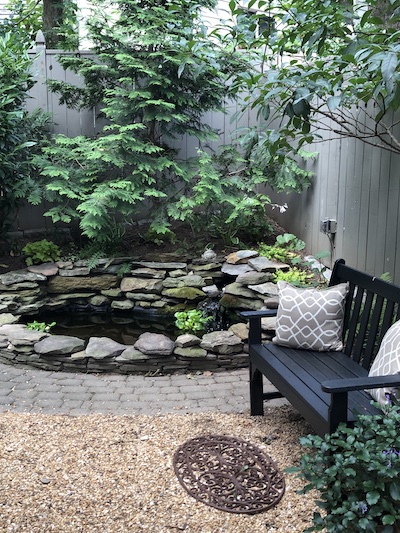Greenspace Jeopardy: Game of Wellness and Garden Facts
By Kathleen Driscoll, Fairfax Master Gardener
“The best remedy for those who are afraid, lonely or unhappy is to go outside, somewhere where they can be quiet, alone with the heavens, nature, and God. Because only then does one feel that all is as it should be and that God wishes to see people happy, amidst the simple beauty of nature. I firmly believe that nature brings solace in all troubles.”– Anne Frank
 Welcome to Greenspace Jeopardy, America’s game show of wellness and garden facts. In this game, the answers and categories are provided, and contestants must come up with the questions.
Welcome to Greenspace Jeopardy, America’s game show of wellness and garden facts. In this game, the answers and categories are provided, and contestants must come up with the questions.
In this game the four categories, including answer clues are:
Financial Outcomes
Cuts hospital budgets through reduced nurse and doctor burnout, staff turnover, worker absenteeism and medical liability.
Increased curb appeal and property value.
Edible results; improves nutrition with fresh vegetables and fruit.
Offers career path of professional employment.
Tree plantings can moderate heating and cooling cost in homes.
Physical Outcomes
Reduces stress.
Burns up to 450 calories an hour.
Improves human physical health.
Incorporates “a plant-dominated environment purposefully designed to facilitate interaction with the healing elements of nature.”
Develops fine motor skills, and hand-eye coordination.
Five Senses
Perfumes a room with lovely scents.
Brightens the table with a cheery bouquet.
Spices up meals, welcomes buzzing bees and singing birds.
Stimulates taste, touch, smell and sound.
Psychological Comfort
Brightens mood and inspires calm.
Boosts concentration and attentional ability.
Decreases anxiety.
Improves mental health.
Contestants, are you ready? Good luck.
If you answered “What can a therapeutic garden or a sensory garden or a healing garden or a restorative garden offer?” you are correct. Many of different titles providing the same curative benefits. Sounds like a miracle, doesn’t it? To add a bit of background, let’s take a brief look at history and the research that promoted the Greenspace Jeopardy responses.
Throughout most of recorded history — and probably unrecorded as well — humans have nurtured plants. As subsistence agriculture grew, it incorporated horticulture; gardens became more than a food necessity. They became a fundamental aspect of civilized life and offered observations about life and culture, frequently religion, as well.
Early examples of outdoor religious spaces include the Babylonian priests’ temple gardens and the Egyptian funeral gardens. The formal paradise garden of Persia was as theologically didactic as it was sensual, resplendent with water, scent and sound. The sacred groves of China, India and Japan and the temple gardens of the Romans clearly reflected the emphasis placed on plants and underscored the resources devoted to worship. In Celtic and Germanic belief, the focus was on cultivating revered trees. Additional examples of green importance in religious tradition were the Medieval monastery gardens and the Renaissance Vatican gardens.
However, organized religion possessed no exclusive right to the human spirit and the healing power of nature. Quite understandably, gardens became sanctuaries of reflection, contemplation and meditation. Each season celebrates and surprises and reenforces the spiritual aspect of such a restorative space. Mere bird feeders, water features, windchimes, gazing globes, statuary and even plastic pink flamingoes metamorphize into a highly personal, sensory-orientated, mystical healing garden. From soul-affirming spiritual practice to health care rehabilitation was but a short step.
Founding Father and signer of the Declaration of Independence, Philadelphia physician Dr. Benjamin Rush, observed that “It has been remarked that the maniacs of the male sex in all hospitals, who assist in cutting wood, making fires, and digging in a garden, . . . often recover, while persons, whose rank exempts them from performing such services, languish away their lives within the walls of the hospital.” This was in 1812 and the therapeutic benefits of the garden were being medically acknowledged. Not surprisingly, the first US hospital to incorporate greenhouse medicine as patient healing was the Friends Hospital in Philadelphia. This would be the infancy of American horticultural therapy.
Today, horticultural therapy joins occupational therapy, speech therapy and behavioral therapies in promoting physical, emotional and cognitive well-being. To achieve these outcomes, patients follow a nature-based treatment plan. Simple activities such as garden maintenance (prune shrubs; weeding and mulching plants), plant propagation (rooting cuttings; separating overgrown Hosta), food production (growing a salad garden; planting vegetables and herbs) instill a satisfying sense of purpose, responsibility and accomplishment. Individuals suffering dementia, post-traumatic stress disorder (PTSD), terminal illness and loss of a loved one realize amazing results.
As Hippocrates said, “Nature itself is the best physician.”
Clearly, as Greenspace Jeopardy question and answers show, the garden marries form and function, beauty and wellness, calm and tranquility. It is a source of nourishment for body and soul. The joy of a gardenia bouquet, the pride of homemade salsa and the music of buzzing bees combine fragrance, flavor and sound. The blend of herbs, vegetables and cutting flowers are products of human labor and resources with a touch of something greater than ourselves, and a nod to the divine.
This is the therapeutic healing garden.
Resources
• 54 Profound Quotes On The Healing Power Of Nature, by Mukesh Mani
• American Horticultural Therapy Association, National Association of Activity Professionals
• Benjamin Rush, Founding Father and Signer of the Declaration of Independence
• Calories Burned Gardening Calculator & Formula, Seneca Labs
• Effects of Biophilic Nature Imagery on Indexes of Satisfaction in Medically Complex Physical
Rehabilitation Patients: An Exploratory Study 2001, Matthew J. Wichrowski, John R. Corcoran, Francois
Haas, Greg Sweeney, and Arlene Mcgee, Health Environments Research and Design Journal, Center
for Health Design
• Spiritual Gardening: Creating Sacred Space Outdoors, by Peg Streep
• Take Burnout from Red to Green, Sean M. Murphy and Angela Walseng, Joan & Sanford I. Weill
Medical College of Cornell University